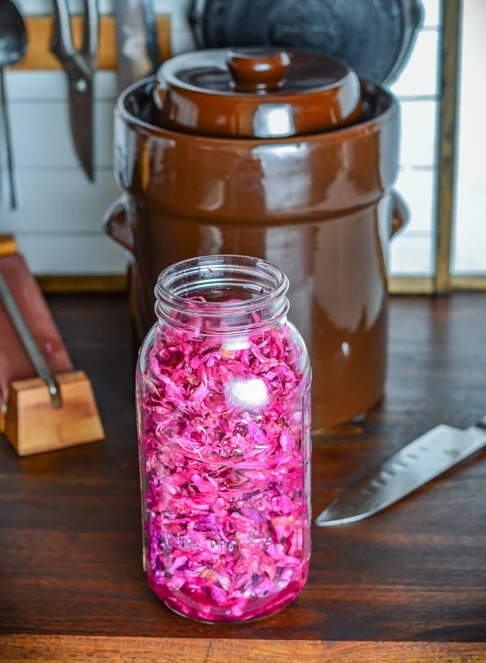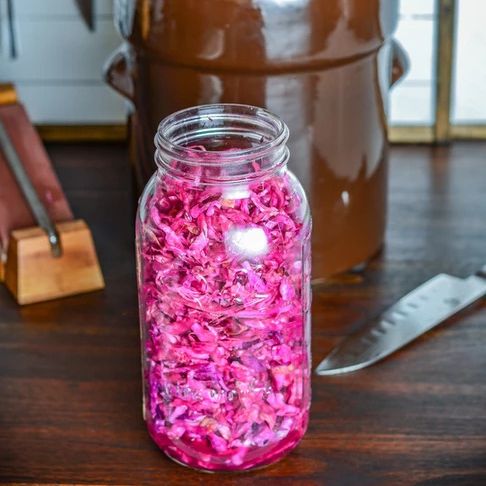In the world of fermented foods sauerkraut is probably the most recognized here in the United States and for good reason. Its great on sandwiches, hot dogs, sausages, cooked in stews and served along side braised meats.
Besides being delicious, its also pretty dang nutritious. It's most notably claim to health fame is when the 18th century English explorer Captain James Cook stumbled upon sauerkraut and sailed with it during his voyages. The fermented barrels of goodness was deemed responsible for nipping scurvy in the bud by providing the crews with much needed vitamin C. Today it is mostly know for its beneficial gut health benefits.
To most people, sauerkraut may seem like a daunting task that requires superior culinary skills, but it's quite the opposite. All that you need is a ceramic fermentation crock set like the one that I use from LEM Products and Roots & Harvest. Their water seal crock sets include the crock, weights and lid which is everything that you need. These are constructed with sturdy stoneware clay which gives me a peace of mind being that I don't like fermenting foods in plastic containers.
I won't get into the nitty gritty of the health reasons for not using plastics for fermenting, but there are plenty of articles on the web for research. You do have the option to use a food grade plastic bucket, sturdy non-reactive plate, a gallon jug filled with water for using as a weight and cheese cloth as a lid if you're in a pinch. But as mentioned above, I don't recommend this.
Timeframe: 1 to 4 weeks (can take longer in cold environments)

Cooks Notes:
- You can add in other seasonings, vegetables and fruits to your cabbage base. Examples are carrots, beets, apples, caraway seeds, celery seeds and juniper.
- Try adding in red cabbage with green cabbage. This makes for an almost florescent pink kraut that looks amazing on a giant Ruben sandwich.
Ingredients
- 5 pounds of cabbage
- 3 tablespoons kosher salt
Equipment
- Option 1: 4 liter capacity or bigger ceramic crock (with provided weights and lid)
- Option 2: food grade plastic bucket, plate to fit inside bucket, 1 gallon jug filled with water, cheese cloth or towel for covering bucket
Instructions
- Chop the cabbage thinly with a knife, grate or shave with a mandolin.
- In a large bowl or meat lug, add the cabbage. Sprinkle the cabbage with the salt as you toss to coat.
- One handful at a time add the cabbage to your crock or bucket, pressing the cabbage down firmly with your fist after each addition. Pressing helps pack the cabbage tightly and aids in forcing water out.
- Place the weights inside of the crock. If using a bucket, place in the plate and the gallon jug of water on top. Cover the crock with its lid. If using a bucket, cover with a towel or cheese cloth and secure. Every couple of hours, press down on your weights to help draw out water from the cabbage. Do this until the water level has risen above the cabbage. This can take up to 24 hours. If after 24 hours the water level is not above the cabbage, simply add salted water with a ratio of 1 tablespoon to 1 cup of water to the container until it rises above the cabbage. Cover your vessel.
- Place the crock somewhere in your home where you won't forget about it. You'll be checking on it every day or so. If you notice any mold do not worry, this is simply a bloom. The sauerkraut is protected by the salty brine. Skim off what you can and cover the vessel back up.
- After about 4 to 5 days, start tasting the sauerkraut for flavor and texture. The flavor gets better and stronger over time. If your vessel is stored in cool room, your sauerkraut will mature at a much slower rate than if it is stored in a warm environment.
- After the flavor has reached your liking you can either transfer the entire batch to the refrigerator or scoop out only what you need. Scooping out only what you need lets your sauerkraut ferment further, thus creating new depths of flavor. Then when it reaches full flavor maturity, you can transfer to the refrigerator. Just make sure you keep your weights clean and the sauerkraut submerged under the brine as you tinker. If you find yourself low on brine, add in salted water with a ratio of 1 tablespoon kosher salt to 1 cup of water.
 Larry White (@wildgamegourmet) is a hunter, avid outdoorsman and former restaurant chef whose life revolves around food and being in wild places. He grew up in the foothills of North Carolina spending his childhood hunting, fishing and walking the woods as much as possible. He was also lucky enough to grow-up beside of his grandma who was a phenomenal cook and the person that ultimately inspired Larry to become a chef.
Larry White (@wildgamegourmet) is a hunter, avid outdoorsman and former restaurant chef whose life revolves around food and being in wild places. He grew up in the foothills of North Carolina spending his childhood hunting, fishing and walking the woods as much as possible. He was also lucky enough to grow-up beside of his grandma who was a phenomenal cook and the person that ultimately inspired Larry to become a chef.



 Larry White (@wildgamegourmet) is a hunter, avid outdoorsman and former restaurant chef whose life revolves around food and being in wild places. He grew up in the foothills of North Carolina spending his childhood hunting, fishing and walking the woods as much as possible. He was also lucky enough to grow-up beside of his grandma who was a phenomenal cook and the person that ultimately inspired Larry to become a chef.
Larry White (@wildgamegourmet) is a hunter, avid outdoorsman and former restaurant chef whose life revolves around food and being in wild places. He grew up in the foothills of North Carolina spending his childhood hunting, fishing and walking the woods as much as possible. He was also lucky enough to grow-up beside of his grandma who was a phenomenal cook and the person that ultimately inspired Larry to become a chef.